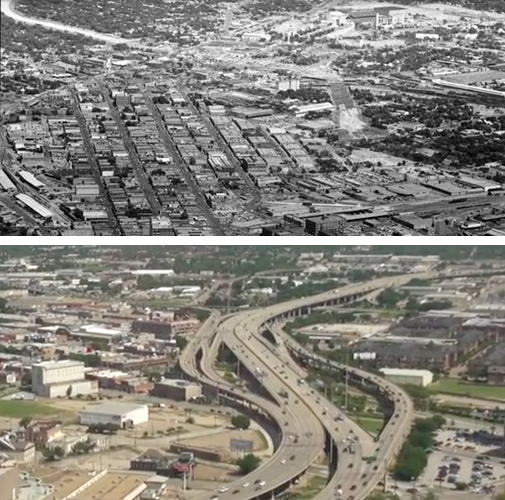I-345 in Dallas is a remnant of America's 1960s highway-building binge, which leveled city neighborhoods to make way for huge grade-separated roads. With the segment in central Dallas approaching the end of its design life, a growing movement has called for its removal, which would enable the city to reconnect downtown and the neighborhood of Deep Ellum.
The idea that Dallas needs to reconsider its relationship to highways is central to an ascendant political coalition in the city. Recently the City Council announced it would discontinue planning for the Trinity Toll Road, a $1.7 billion urban highway.
The latest news involves I-345. Though it's not the highway teardown advocates want, Texas DOT is now considering putting the 1.3-mile highway segment underground, reports Robert Wilonsky at the Dallas Morning News. A recent conversation he had with TxDOT Commissioner Victor Vandergriff leads Wilonsky to believe there's been a significant shift in thinking at the agency:
Vandergriff said — and here's the wild part — that not only is it possible we'll see 345 get vanished in the next two decades, but it's a very real "probability."
Which floored me, because on a cold December night in 2012, I attended a TxDOT meeting across from Dallas Love Field where the spokesmen and engineers were shrugging off any talk about razing the overpass. That night they offered nine possibilities for the future of the disintegrating 345, eight of which were just different shades of "rebuild." And for years after, TxDOT was telling everyone 345 was going to live forever. Then-council member Vonciel Jones Hill said the same thing.
And now here we were talking about the likelihood of burying it.
And I mean that literally — as in, sinking the freeway below grade and decking it, maybe with a park but more than likely with mixed-use and commercial developments that would restitch the city center with Deep Ellum and East Dallas.
Not to diminish the excitement, but burying and capping I-345 would likely be very expensive and fall far short of the improvement in walkability that a real teardown would enable.
Patrick Kennedy, who spearheaded the campaign to tear down the highway, told Wilonsky he'd prefer an at-grade street network that disperses traffic, while Vandergriff maintained that "TxDOT is about congestion relief and connectivity" -- i.e. moving cars. But apparently Kennedy's work highlighting how much land is consumed by the highway has had an effect on TxDOT officials.
More recommended reading today: TheCityFix shares photos showing how Sao Paolo is using colorful, inexpensive materials to redesign its streets and repurpose space from cars to people. And BuildZoom uses housing prices to identify urban areas that should allow greater density.






